Migratory fish species: living between the sea and the river
Of the more than 32,000 fish species known to science, 58% live in the sea, 41% in freshwater, and less than 1%, the so called diadromous fish, occur in both ecosystems, at different stages of their life cycle. The designation diadromous derives from the classic Greek and is constituted by two words, [Dia], which means "through", and [Dromos], the Greek word for running. In other words, diadromous fish run (i.e. migrate) through distinct environments, namely freshwater and saltwater ecosystems.
- i) Anadromy (from the Greek Ana "up"): Diadromous fishes in which most feeding and growth occur at sea prior to migration of adults into freshwater to reproduce (e.g. salmon, sea lamprey, sturgeons, shads);
- ii) Catadromy (from the Greek Cata "down): Diadromous fishes in which most feeding and growth occur in freshwater prior to migration of adults to sea to reproduce (e.g. European eel; thinlipped grey mullet; European flounder).
 Schematic representation of the life-cycles of anadromous and catadromous fish species. |
Besides anadromy and catadromy, other type of migration can be found in freshwater fish, the so called potamodromous species (from the Greek Potamos "river"). Potamodromous fish also perform migratory movements, for feeding or reproductive purposes, but entirely on freshwater habitats (e.g. barbel, nase, river trout).
Diadromous and potamodromous fish are affected by a vast number of threats usually present in aquatic ecosystems, such as water pollution, habitat degradation and the introduction of non-indigenous species. However, due to the specificities of their life cycle and the high economical value of some of these species, the main threats affecting migratory fish, especially diadromous ones, are:
i) the loss of longitudinal connectivity and habitat fragmentation caused by dam and weir construction in river systems;
ii) the overexploitation of these resources by professional fishermen and poaching.